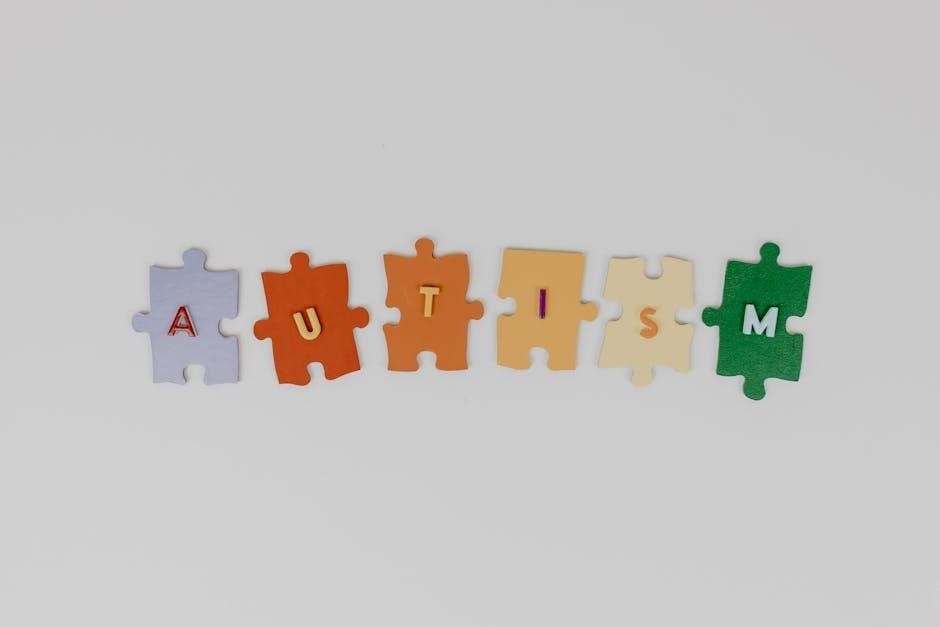The 40 Developmental Assets are research-based building blocks of healthy development, identified by the Search Institute, promoting positive growth in adolescents through internal and external strengths․
Definition and Overview
The 40 Developmental Assets are a comprehensive framework of positive experiences and qualities identified by the Search Institute to support healthy development in adolescents․ These assets are categorized into internal and external strengths, focusing on social-emotional growth, values, and supportive relationships․ They serve as building blocks for helping young people thrive, fostering resilience, and promoting positive outcomes․ The framework emphasizes the importance of community, family, and individual contributions to nurturing these assets․ By addressing both internal strengths, such as identity and thinking skills, and external supports, like relationships and boundaries, the 40 assets provide a holistic approach to adolescent development․
Importance of Developmental Assets in Adolescent Development
The 40 Developmental Assets play a crucial role in shaping the lives of adolescents, providing a foundation for healthy growth and development․ These assets address the critical needs of young people during a transitional phase, helping them navigate challenges and build resilience․ By fostering positive relationships, clear boundaries, and a sense of empowerment, the assets promote emotional well-being, academic success, and responsible behavior․ They also reduce the risk of negative outcomes such as substance abuse or delinquency․ The framework emphasizes the importance of community and family engagement in nurturing these assets, ensuring adolescents develop into caring, capable, and confident individuals prepared for future success․

Origin and Development of the 40 Developmental Assets
The Search Institute developed the 40 Developmental Assets framework through extensive research, identifying essential supports and strengths that promote healthy development in adolescents, fostering resilience and success․
History of the Search Institute
The Search Institute, founded in 1958, is a nonprofit organization dedicated to promoting healthy children and communities․ Initially focused on addressing social issues, it shifted to prevention and developmental approaches․ In the late 1990s, the institute introduced the 40 Developmental Assets, a groundbreaking framework identifying essential supports for adolescent well-being․ This research-based model emphasizes strengths over deficits, fostering resilience and positive outcomes․ Today, the Search Institute remains a leader in youth development, providing resources and surveys to measure asset levels nationally․ Its work continues to guide families, schools, and communities in nurturing capable, caring, and responsible young people․
Research Behind the 40 Developmental Assets
The 40 Developmental Assets are rooted in extensive research by the Search Institute, which analyzed data from surveys of adolescents nationwide․ The framework identifies 40 key experiences and qualities that promote healthy development․ These assets are divided into internal and external categories, reflecting the dual influences of personal strengths and environmental supports․ Research findings consistently show that young people with more assets are more likely to thrive academically, socially, and emotionally, while being less likely to engage in risky behaviors․ The Search Institute continues to refine its research, ensuring the framework remains evidence-based and effective in fostering positive youth development across diverse communities․

Categories of Developmental Assets
The 40 Developmental Assets are categorized into Internal Assets and External Assets, focusing on personal strengths and environmental supports that foster healthy adolescent development․
Internal Assets
Internal Assets are personal strengths and characteristics that guide young people’s behavior and decisions․ They include Social-Emotional Strengths, such as empathy, self-control, and integrity, which help adolescents navigate relationships and challenges․ Values and Identity involve a sense of purpose, faith, and personal identity, fostering resilience and direction․ Thinking and Learning Skills encompass critical thinking, academic motivation, and interpersonal skills, promoting academic success and lifelong learning․ These assets empower adolescents to develop a strong sense of self and the abilities needed for healthy growth and responsible decision-making, laying the foundation for thriving in life․
External Assets
External Assets are the positive influences and supports in a young person’s environment that contribute to healthy development․ These include Supportive Relationships, such as family support, positive adult role models, and caring neighbors, which provide emotional and practical guidance․ Boundaries and Expectations involve clear rules, consistent consequences, and high standards set by family and community, helping adolescents understand right from wrong․ Empowerment and Participation focus on opportunities for youth to contribute to their communities, feel valued, and develop leadership skills․ Together, these assets create a nurturing environment that encourages positive behaviors, reduces risks, and fosters a sense of belonging and responsibility in young people․
Four Asset Areas
The 40 Developmental Assets are organized into four key areas that promote holistic development․ The first area, Support, focuses on relationships with family, adults, and community members who provide emotional and practical guidance․ The second area, Boundaries and Expectations, emphasizes clear rules, consistent consequences, and high standards that help youth understand right from wrong․ The third area, Empowerment, involves opportunities for young people to take on meaningful roles and feel valued in their communities․ The fourth area, Constructive Use of Time, highlights activities that promote learning, creativity, and personal growth, such as sports, arts, and community service․ Together, these areas create a balanced foundation for healthy development․

Internal Assets in Detail
Internal assets are personal qualities that nurture adolescents’ development, including social-emotional strengths, values, and thinking skills, helping them navigate challenges and build a strong sense of identity․
Social-Emotional Strengths
Social-emotional strengths are essential internal assets that enable adolescents to navigate relationships, manage emotions, and develop resilience․ These include skills like empathy, self-awareness, and self-control, which foster positive interactions and decision-making․ Adolescents with strong social-emotional strengths are better equipped to handle stress, communicate effectively, and build healthy relationships․ These qualities also promote a sense of responsibility and respect for others, laying the foundation for lifelong social and emotional well-being․ By fostering these strengths, families and communities can help young people develop the confidence and competence needed to thrive in all areas of life․ These assets are critical for adolescent development and long-term success․
Values and Identity
Values and identity are critical internal assets that shape an adolescent’s moral compass and sense of self․ These assets include integrity, honesty, responsibility, and cultural identity, guiding young people to make ethical decisions and respect others․ A strong sense of identity helps adolescents navigate societal expectations and develop a positive self-image․ Family, community, and cultural influences play a significant role in fostering these values, enabling youth to build resilience and contribute positively to society․ By instilling these values, adults help adolescents establish a foundation for lifelong character development and a clear understanding of their purpose in the world․
Thinking and Learning Skills
Thinking and learning skills are essential internal assets that foster critical thinking, problem-solving, and decision-making abilities in adolescents․ These skills include critical thinking, problem-solving, decision-making, and a commitment to lifelong learning․ Adolescents with strong thinking skills are better equipped to navigate challenges, set goals, and achieve academic success․ Encouraging curiosity and providing opportunities for intellectual growth help youth develop these skills․ Adults play a crucial role by modeling thoughtful behavior and supporting educational pursuits․ These assets not only enhance academic performance but also prepare young people for future challenges, promoting resilience and adaptability in an ever-changing world․

External Assets in Detail
External Assets are supportive relationships and opportunities outside the individual, such as family, school, and community, providing guidance, boundaries, and empowerment that crucially foster positive development in adolescents․
Supportive Relationships
Supportive relationships are foundational external assets that provide adolescents with emotional and practical support․ These relationships include family members, mentors, teachers, and community figures who foster trust, guidance, and encouragement․ Positive interactions with caring adults and peers help adolescents develop a sense of belonging and security․ Such relationships are critical for building resilience and promoting healthy development․ The Search Institute emphasizes that supportive relationships are among the most influential assets, as they create environments where young people feel valued and supported․ These connections often serve as a protective factor against risks and challenges, enabling adolescents to thrive academically, socially, and emotionally․
Boundaries and Expectations
Boundaries and expectations are external assets that provide adolescents with clear guidelines and high standards for behavior․ These assets help young people understand right from wrong and feel secure․ They include consistent rules at home, school, and in the community, as well as encouragement to achieve their potential․ According to the Search Institute, these boundaries foster self-discipline and responsibility․ When adults and institutions set high expectations, adolescents are more likely to develop positive habits and strive for success․ These assets play a crucial role in shaping healthy behaviors and aspirations, helping adolescents navigate challenges and build resilience for long-term well-being․
Empowerment and Participation
Empowerment and participation are external assets that enable adolescents to feel valued and involved in their communities․ These assets include opportunities for youth to make a difference, express their voice, and take on meaningful roles․ According to the Search Institute, empowerment fosters a sense of purpose and confidence, encouraging young people to contribute positively to society․ Participation in community service, leadership roles, and decision-making processes helps build resilience and responsibility․ When adolescents feel empowered, they are more likely to develop a strong sense of identity and commitment to improving the world around them, leading to lasting positive outcomes․

Measuring the Developmental Assets
Measuring the 40 Developmental Assets involves surveys and assessments to evaluate their presence in adolescents’ lives․ This data helps communities identify strengths and gaps, guiding targeted initiatives to support youth development․
Surveys and Assessments
The Search Institute conducts surveys to measure the presence of the 40 Developmental Assets in adolescents’ lives․ These assessments are administered to students in grades 7, 9, and 10 across the U․S․, providing insights into the average number of assets young people experience․ The data collected helps communities identify strengths and areas for improvement․ Surveys focus on both internal and external assets, offering a comprehensive view of youth development․ The results are used to inform strategies that foster healthy growth and resilience․ By understanding the distribution of assets, communities can tailor initiatives to address specific needs and create supportive environments for adolescents․
Research Findings and Data
Research by the Search Institute reveals that young people who experience more of the 40 Developmental Assets are more likely to thrive academically, socially, and emotionally․ Data collected from surveys of adolescents across the U․S․ shows that, on average, youth report having approximately 19․3 assets out of 40․ These findings highlight the importance of fostering both internal and external assets to promote resilience and reduce risky behaviors․ The data also indicates that higher asset levels are associated with better academic performance, increased empathy, and lower rates of substance abuse․ These insights provide a foundation for communities to develop targeted strategies to support adolescent development effectively․
Impact of the 40 Developmental Assets
The 40 Developmental Assets significantly enhance adolescents’ well-being, promoting academic success, emotional resilience, and positive relationships, while reducing risky behaviors like substance abuse and violence․
Positive Outcomes for Adolescents
The 40 Developmental Assets foster resilience, responsibility, and thriving in adolescents․ Research shows that young people with more assets experience improved mental health, better academic performance, and stronger relationships․ They are less likely to engage in risky behaviors such as substance abuse or violence․ The assets promote a sense of purpose, confidence, and empathy, equipping adolescents to navigate challenges effectively․ Studies by the Search Institute indicate that higher asset levels correlate with increased likelihood of succeeding in school and life․ These positive outcomes create a foundation for long-term success, helping adolescents grow into capable, caring, and responsible individuals․ The framework empowers communities to nurture these strengths systematically․
Community and Family Engagement
Community and family engagement are vital components of the 40 Developmental Assets, fostering a supportive environment for adolescent growth․ Families play a crucial role by providing love, guidance, and high expectations, while communities create opportunities for participation and empowerment․ When families and communities collaborate, they help adolescents develop resilience and a sense of belonging․ Research by the Search Institute highlights that strong family and community ties reduce risky behaviors and enhance positive outcomes; Engaged families and communities ensure that young people feel valued, supported, and connected, which are essential for their healthy development․ This collective effort nurtures the assets needed for adolescents to thrive․

Examples of Developmental Assets in Action
Mentorship programs and community service initiatives exemplify developmental assets in action, fostering supportive relationships and empowering youth to develop essential life skills and values․
Real-Life Applications
Mentorship programs, community service, and after-school clubs are examples of developmental assets in action․ These initiatives provide supportive relationships and opportunities for youth to develop social-emotional strengths․ Parent-teacher associations and family dinners foster a sense of belonging and identity․ Schools integrate asset-building into curricula, promoting thinking skills and responsibility․ Community organizations offer empowerment through leadership roles, helping adolescents navigate challenges․ These real-life applications enhance resilience, improve academic performance, and strengthen community bonds, illustrating how the 40 Developmental Assets can be effectively implemented to support adolescent growth․
Success Stories
Communities and organizations have seen transformative results by implementing the 40 Developmental Assets․ For instance, Pearlands Vic Coppinger Family YMCA adopted the framework, leading to improved youth behavior and increased participation in community activities․ Schools reporting high asset levels noted better academic performance and reduced disciplinary issues․ Families emphasizing asset-building practices observed stronger parent-child relationships and higher self-esteem in adolescents․ These successes highlight how focusing on developmental assets fosters resilience, responsibility, and positive outcomes․ By prioritizing these building blocks, communities create nurturing environments where young people thrive, demonstrating the long-term impact of asset-based approaches on healthy adolescent development․
Challenges in Building Developmental Assets
Building developmental assets faces challenges like resource limitations, inconsistent implementation, and societal pressures, often hindering the cultivation of necessary strengths in adolescents․
Common Barriers
Common barriers to building developmental assets include resource limitations, inconsistent implementation, and societal pressures․ Many communities face funding constraints, limiting access to asset-building programs․ Additionally, varying levels of commitment from stakeholders can lead to uneven implementation․ Societal challenges, such as poverty and discrimination, further exacerbate these issues, creating systemic obstacles for adolescents․ Cultural norms and priorities may also hinder the adoption of asset-building practices․ These barriers highlight the need for targeted strategies to ensure equitable access to developmental assets for all young people․ Understanding these challenges is crucial for developing effective solutions to support adolescent growth and well-being․
Strategies to Overcome Challenges
To overcome barriers in building developmental assets, communities can adopt targeted strategies․ Building strong partnerships among schools, families, and local organizations ensures resource sharing and consistent implementation․ Engaging families through education and involvement helps address societal pressures․ Providing professional development for educators and mentors enhances their ability to support asset-building․ Culturally sensitive programming tailors interventions to diverse needs, fostering inclusivity․ Leveraging technology and digital platforms expands access to asset-building resources, especially for underserved populations․ By prioritizing equity and collaboration, communities can create environments where all adolescents thrive․ These strategies require sustained commitment and innovation to dismantle systemic barriers effectively․
The 40 Developmental Assets provide a proven framework for fostering healthy adolescent development․ Future efforts should focus on refining strategies, expanding research, and enhancing community engagement to ensure all youth thrive․
The 40 Developmental Assets, identified by the Search Institute, are essential building blocks for healthy adolescent development․ They are categorized into internal and external assets, focusing on strengths like social-emotional skills, values, and supportive relationships․ Research shows that the more assets youth possess, the better their outcomes, including academic success, positive behavior, and resilience․ These assets empower communities and families to create nurturing environments, fostering caring and responsible individuals․ By understanding and promoting these assets, society can address barriers and enhance opportunities for all adolescents, ensuring they thrive emotionally, socially, and academically․
Future Implications for Adolescent Development
The 40 Developmental Assets framework offers a promising path for fostering resilience, emotional intelligence, and community engagement in future generations․ By prioritizing these assets, families, schools, and communities can create environments that nurture adolescents’ potential․ Future strategies should focus on integrating these assets into policies and programs, ensuring equitable access for all youth․ Continuous research and adaptation of the framework will be essential to address evolving societal challenges․ The emphasis on strengths-based development will empower adolescents to thrive, contributing to healthier, more compassionate communities․ This approach aligns with global efforts to promote mental health, education, and social equity, paving the way for a brighter future․